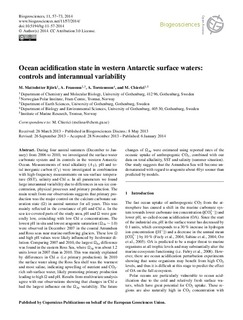| dc.contributor.author | Mattsdotter Björk, My | |
| dc.contributor.author | Fransson, Agneta | |
| dc.contributor.author | Chierici, Melissa | |
| dc.contributor.author | Torstensson, A. | |
| dc.date.accessioned | 2014-02-07T08:16:03Z | |
| dc.date.accessioned | 2014-02-08T04:02:10Z | |
| dc.date.available | 2014-02-07T08:16:03Z | |
| dc.date.available | 2014-02-08T04:02:10Z | |
| dc.date.issued | 2014-01-06 | |
| dc.identifier.citation | Mattsdotter Björk, M., Fransson, A., Torstensson, A., and Chierici, M.: Ocean acidification state in western Antarctic surface waters: controls and interannual variability, Biogeosciences, 11, 57-73, doi:10.5194/bg-11-57-2014, 2014. | |
| dc.identifier.issn | 1726-4170 | |
| dc.identifier.uri | http://hdl.handle.net/11250/108144 | |
| dc.description.abstract | During four austral summers (December to January) from 2006 to 2010, we investigated the surface-water carbonate system and its controls in the western Antarctic Ocean. Measurements of total alkalinity (AT), pH and total inorganic carbon (CT) were investigated in combination with high-frequency measurements on sea-surface temperature (SST), salinity and Chl a. In all parameters we found large interannual variability due to differences in sea-ice concentration, physical processes and primary production. The main result from our observations suggests that primary production was the major control on the calcium carbonate saturation state (Ω) in austral summer for all years. This was mainly reflected in the covariance of pH and Chl a. In the sea-ice-covered parts of the study area, pH and Ω were generally low, coinciding with low Chl a concentrations. The lowest pH in situ and lowest aragonite saturation (ΩAr ~ 1.0) were observed in December 2007 in the coastal Amundsen and Ross seas near marine outflowing glaciers. These low Ω and high pH values were likely influenced by freshwater dilution. Comparing 2007 and 2010, the largest ΩAr difference was found in the eastern Ross Sea, where ΩAr was about 1.2 units lower in 2007 than in 2010. This was mainly explained by differences in Chl a (i.e primary production). In 2010 the surface water along the Ross Sea shelf was the warmest and most saline, indicating upwelling of nutrient and CO2-rich sub-surface water, likely promoting primary production leading to high Ω and pH. Results from multivariate analysis agree with our observations showing that changes in Chl a had the largest influence on the ΩAr variability. The future changes of ΩAr were estimated using reported rates of the oceanic uptake of anthropogenic CO2, combined with our data on total alkalinity, SST and salinity (summer situation). Our study suggests that the Amundsen Sea will become undersaturated with regard to aragonite about 40 yr sooner than predicted by models. | |
| dc.language.iso | eng | |
| dc.title | Ocean acidification state in western Antarctic surface waters: controls and interannual variability | |
| dc.type | Journal article | |
| dc.type | Peer reviewed | |
| dc.date.updated | 2014-02-07T08:16:04Z | |
| dc.identifier.doi | 10.5194/bg-11-57-2014 | |
| dc.identifier.cristin | 1110553 | |
